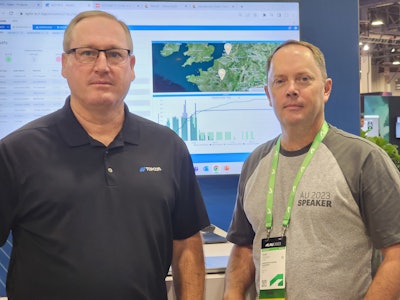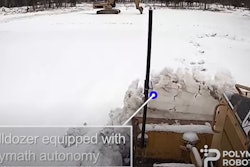
Almost 35% of construction contractors are using or budgeting for machine control technologies according to a 2023 study by IRONPROS and ForConstructionPros. This includes solutions from original equipment manufacturers (OEMs) and aftermarket providers.
Each machine control solution vendor providing systems to OEMs or directly to end users in the aftermarket have unique and proprietary specifications for the topographic data used to communicate the design for earthmoving machines to render and as-built data returned once work is completed.
For several reasons, this is a challenge the industry is working together to solve:
- The growth of machine control for earthmoving
- The prevalence of mixed equipment fleets
- Increased reliance on rental assets
- The fact that subcontractors often have different machine control technologies than the prime contractor
The Association of Equipment Management Professionals (AEMP)-backed ISO 15143 Standard pushed the needle toward greater interoperability of telematics data, and Part 4 of the proposed ISO/AWI TS 15143 standard could do the same for topographic data relied on by earthmoving machines that automate the completion of a design to a specified grading plan.
A Manual Process
According to Caterpillar Engineering Manager Chad Brickner, Cat and other companies in the grade control sector are working on a solution, but there are currently no easy answers. Brickner confirmed that Caterpillar is involved with the ISO/AWI TS 15143 Standard efforts.
“We're excited about that because it's interesting seeing a lot of different players from manufacturers like ourselves showing control companies that are also participating that everybody is coming together,” Brickner said. “I've looked through the AEMP standard that was put out a few years ago, and that delivers great interoperability on the management side. It has really set up a lot of other things that are desperately needed in this machine control stuff so that I can use it. That's the only way forward that I see.”
According to Brickner, the current solution to this lack of interoperability is manual work.
“From what I've seen, they're using people, the people that are willing to put in the work,” Brickner said. “Contractors are using the different pieces of technology that all of us offer. They are solutions that work. But they're all unique to a specific vendor.”
Topcon Aptix Prioritizes Topographic Data
In July 2023, Topcon launched its Aptix integration platform-as-a-service (IPaaS) application for field and site data.
Aptix automates and orchestrates the distribution of data, including:
- Machine control files
- Constructible models
- Project schedules
- Reports on actuals
It shows, in near real-time, the location of machines with the ability to aggregate as-built data from mixed fleet telematics. It provides real-time reports on people, materials, machine, and carbon dioxide emissions, creating greater visibility for carbon footprint and sustainability initiatives.
Topcon Global Director of Business Development and Marketing, Integration Services Scott Langbein said that while this is an iPaaS product, it focuses on earthwork, connected equipment and models rather than the business transactional processes iPaaS offerings like Agave or Trimble Integrations will streamline.
The Aptix platform will not be everything to all people—there are, according to Langbein, no plans to extend the solution to takeoffs, for instance. In a September 2023 IRONPROS discovery call, Langbein said that the focus was on capturing data from takeoff tools in products from partners including Autodesk, HCSS, or AgTek. The initial focus, according to Langbein, has been on 3D machine control. Starting with 3D machine control makes sense because contractors may be using equipment with multiple machine control systems from different manufacturers, each with their proprietary software.
“We connect most heavy equipment: excavators, motor graders, dozers and scrapers,” Langbein said. “For the most part, these types of equipment have several options in themselves as to what GPS control or total station machine control technology they have access to. We have a tier of all heavy equipment that is machine controlled. And then the next tier down is heavy equipment that is only telematics controlled. And the telematics, we like to simplify that and track just location on and off, and that—that’s just telematics. But over and above that, Topcon’s sweet spot is really the machine control where you're controlling the blade, and you're automating the blade to the model. You're telling the operator to follow the task based on the schedule.”
Apart from capturing data from and relaying models to the machine, Aptix can tie execution in the field into the project schedule.
“The schedule has the task. The task has the model. The machine has the hydraulic control, and the operator is performing in line with the plan—that is the top tier,” Langbein said.
Compact Equipment & Attachment Automation
Aptix is not just focused on heavy iron—it is encompassing data flows with more compact machines and attachments.
“The trend has been towards compact machine control,” Langbein said. “The smaller Bobcats, you know, compact track loaders, machines that run around on a little track, one guy driving a little bucket. The industry's made a number of attachments for these devices—drag boxes for grading, backhoe arms, different solar power pile drivers and things. We're also pursuing that because those have machine control or telematics as well. And that's where the numbers are. John Deere, Komatsu, Topcon and Trimble and, like, everybody is pursuing that space with those compact machine controls.”
There will be a shaking out, Langbein said, between open technologies like Aptix that communicate with this far-flung assortment of machines and solutions from OEMs.
Proprietary barriers are falling between other business applications, including enterprise resource planning and other back-office tools as application programming interfaces (APIs) enable what Gartner called the composable enterprise of integrated but separate software products underpinning business processes.
“There are some technical hurdles that we just need to negotiate and work through as a partner,” Langbein said.
Selecting Grade Control for Interoperability
Even without an ISO standard, some grade control technologies will be able to at least make available an open file or APIs that can enable topographic data to cross over into other software environments, according to Topcon Vice President Jason Hallett.
“A contractor can go to the manufacturer or at least the representative of the manufacturer and say, ‘What are you guys doing with regard to your API's and access to the data?’ How do I get access to that because I have a system that is going to need to integrate with that,” Hallett said. “And if you make your choice at that level, your choices become clearer because there's going to be a handful of them out there that say, yep, we have a program for that; it's priced like this, and this is how you do it. That's a conversation you have to have if you're planning [to buy] a machine today because the average life is approximately seven years.”
Access to APIs is typically not free. As grade control technology vendors prepare to support data management for mixed fleets and as standardization takes hold, Hallett and Langbein say fee structures and contractual arrangements will take shape to bring this interoperability to market.
“But right now, if they have an API that allows integration, it's not a problem for us on the Aptix side,” Hallett said.
Sever the Tie With Hardware?
The AEMP telematics standard has enough data flowing from one equipment nameplate and the other that companies like Trackunit report that many of their customers are not using any of their hardware. While a small percentage of very large fleets can negotiate for more of the diagnostic and other data that go beyond the standard, standardization has made a difference.
Companies like Clue Insights, meanwhile, worry less about the standard and more about standardizing and harmonizing data from multiple other OEM and independent equipment tracking technologies. The company offers no tracking hardware, suggesting that the technology used to manage grade control systems may become more open, enabling data to flow across multiple equipment, operational and design software products.





















